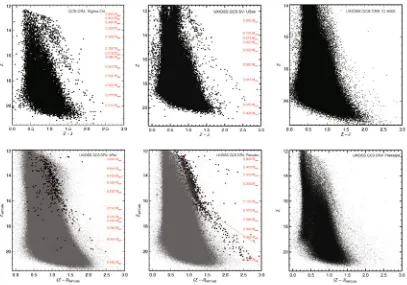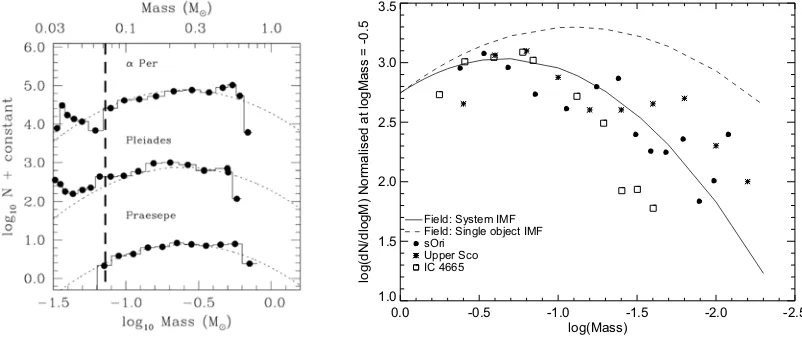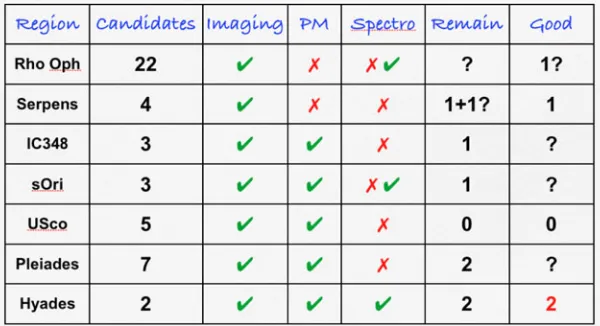DOI: 10.1051/epjconf/20134706001
C
Owned by the authors, published by EDP Sciences, 2013
Ultracool dwarfs in open clusters and star-forming regions
Nicolas Lodieu
1,2,a1Instituto de Astrofísica de Canarias (IAC), Calle Vía Láctea s/n, 38200 La Laguna, Tenerife,
Spain
2Departamento de Astrofísica, Universidad de La Laguna (ULL), 38205 La Laguna, Tenerife,
Spain
3Ramón y Cajal fellow at the IAC
Abstract. In this contribution I review the results of the UKIRT Infrared Deep Sky Survey (UKIDSS)
Galactic Clusters Survey (GCS) on the Initial Mass Function (IMF) and the current searches for young T dwarfs in open clusters and star-forming regions.
1. MAIN ACHIEVEMENTS OF THE UKIDSS GCS
1.1 The UKIDSS GCS
The UKIRT Infrared Deep Sky Survey [UKIDSS;1]1is a deep large-scale infrared survey conducted with the UKIRT Wide field CAMera [WFCAM; 2] equipped with five infrared filters [ZYJHK; 3] and located on the summit of Mauna Kea (Hawaii). All data are pipeline-processed at the Cambridge Astronomical Survey Unit (CASU; Irwin et al. in prep)2, processed and archived in Edinburgh, and later released to the community through the WFCAM Science Archive [WSA;4]3. One of its components, the Galactic Clusters Survey (hereafter GCS) imaged ∼1000 square degrees homogeneously in ten star-forming regions and open clusters down to 0.03–0.01 M (depending on the age and distance of each region) to investigate the universality of the initial mass function (IMF). In addition to the photometry, the latest releases of the GCS provide proper motions measured from the different epochs, with accuracies∼10 milli-arcsec per year (mas/yr). The typical 100% completeness values are J ∼ 19.2 mag andK∼18 mag, respectively.
1.2 GCS targets and main results
Among the ten open clusters and star-forming regions imaged by the GCS, we present here the results on Ori [5], Upper Scorpius [6–9], IC4665 [10], Per [11], the Pleiades [12], and Praesepe [13]. We present examples of the coverage of the GCS in Per, the Pleiades, and Praesepe in Fig. 1. We display the (Z−J,Z) colour-magnitude diagrams for all clusters in Fig.2 and the vector point diagrams for Per, the Pleiades, and Praesepe in Fig.3. The associated mass function are presented
ae-mail:nlodieu@iac.es
1The survey is described atwww.ukidss.org 2The CASU WFCAM webpage is at
http://apm15.ast.cam.ac.uk/wfcam
3WSA is accessible athttp://surveys.roe.ac.uk/wsa
Figure 1. Examples of the UKIDSS GCS DR9 coverage in thePer (56 deg2; left), the Pleiades (80 deg2; middle),
and Praesepe (36 deg2; right) imaged inZY J H Kwith proper motions accurate to a few mas/yr. Overplotted as
black dots are cluster member candidates identified in the GCS.
Figure 2. (Z−J,Z) colour-magnitude diagrams for six regions imaged by the UKIDSS GCS (from top to bottom and left to right):Ori, Upper Scorpius, IC 4665,Per, the Pleiades, and Praesepe.
in Fig. 4. We detail below our results in each cluster, from the youngest (∼3–5 Myr) to the oldest (∼600 Myr):
Figure 3. Proper motion vector point diagrams forPer (left), the Pleiades (middle), and Praesepe (right).
0.0 -0.5 -1.0 -1.5 -2.0 -2.5 log(Mass)
1.0 1.5 2.0 2.5 3.0 3.5
log(dN/dlogM) Normalised at logMass = -0.5
Field: System IMF Field: Single object IMF
Upper Sco sOri
IC 4665
Figure 4. Left: mass functions forPer, the Pleiades, and Praesepe derived photometrically and astrometrically in an homogeneous manner. The (system) field IMF [33] is overplotted as a dotted line. Right: mass functions for
Ori, Upper Sco, and IC 4665 compared to the lognormal form of the system (solid line) and single (dashed line) field IMF [33].
published members in the central 30 arcmin of the cluster [17,18]. We found a total of 287 candidate members down to the deuterium-burning limit with a level of contamination expected below 15%. • Upper Sco is part of the nearest OB association to the Sun, Scorpius-Centaurus (145 pc, 5–10 Myr;
[19–21]). We found that the cluster members define a sequence well separated from field stars in the (Z−J,Z) colour-magnitude diagram (Fig.2). We selected a total of 164 candidates withJ = 10.5– 18.7 mag in 6.5 square degrees surveyed during the science verification phase of the UKIDSS GCS using a variety of colour-magnitude diagrams [7]. We confirmed spectroscopically over 90% of these photometric candidates as spectroscopic members [9]. We also measured the proper motion of all photometric candidates brighter thanJ = 15.5 mag using 2MASS as first epoch [22,23] to further constrain their membership to Upper Sco.
UKIDSS GCS DR9 in the same manner as forPer and identified a sample of∼1000 Pleiades cluster member candidates over 80 square degrees, combining photometry and proper motions derived from the multiple epochs provided by GCS DR9 [12].
• Praesepe is an old (590 Myr; [30]) nearby (182 pc; [28]) cluster with a large mean proper motion of ∼38 mas/yr. As for Per and the Pleiades, we exploited the GCS DR9 and identified over one thousand photometric and astrometric member candidates in 36 square degrees [13].
1.3 The mass function
For all the aforementioned clusters, we derived the luminosity and mass functions using the NextGen and DUSTY models from the Lyon group for consistency [31,32]. The range of masses studied by the GCS vary from one region to the other due to the differences in age and distance but, overall, we are sensitive to low-mass stars and brown dwarfs. The mass functions forPer, the Pleiades, and Praesepe are shown on the left-hand side of Fig.4whereas the mass functions for the other regions are displayed on the right-hand of the same figure. We overplotted the log-normal form of the field mass function [33] for comparison. We do not observe any significant difference (at the 3level) between the shape of all mass functions although some differences are present.
Our main conclusion regarding the universality of the IMF from the homogeneous dataset provided by the UKIDSS GCS is supported by the overall summary of a recent review on the IMF [34]. These authors concluded that (to quote them) “the IMF at the stellar-substellar boundary is still under investigation and uncertainties remain large, but most observations are consistent with a IMF that declines well below the hydrogen-burning limit”; they added that “there is no clear evidence that the IMF varies strongly and systematically as a function of initial conditions”.
2. REVIEW ON SEARCHES FOR YOUNG T DWARFS
Several young regions and open clusters have been surveyed deeply to uncover genuine young T dwarfs. Below, we summarise each survey, compiled in Figure5, and provide their main results:
• A large number of L and T member candidates were reported inOph (∼1 Myr) from a combined 2MASS (J H Ks) and Spitzer (3.6–8.0m) survey [35], including a mid-T dwarf from low-resolution near-infrared spectroscopy [42]. If member of the cloud, its mass would be a few Jupiter masses. The membership of this object was refuted by [43] using an independent optical and near-infrared survey so its nature remains to be explained.
Figure 5. Table showing the regions searched for young T dwarfs and the number of candidates. References are: Oph [35], Serpens [36], IC 348 [37],Orionis [38], Upper Sco [39], the Pleiades [40], and the Hyades [41].
uncover T–type candidates in the heavily embedded core [36]: four candidates were identified after adding near-infrared imaging but two of them were classified as non members from their positions in various colour-magnitude and colour-colour diagrams. The membership of the third candidate remain uncertain whereas the fourth presents all the characteristics of a potential young T dwarf although neither astrometry nor spectroscopy is currently available.
• IC 348 has an age of 1–3 Myr and is located in Perseus where extinction (AV) varies from 2 to 20 mag across the cluster. Three faint T dwarf candidates were identified in a methane survey combined with infrared photometry [37]. The availability of a deep optical survey rejected two of them as T dwarfs, leaving one potential candidate that remains to be confirmed.
• The deep VISTA survey inOrionis [38] doubled the number of known planetary-mass objects in the region [44]. The astrometric measurements for the two known T–type candidates [45–47] suggest that they are proper motion non members at the 2level. One new T candidate was identified (SOri J053804.65−021352.5; [38]) but lacks astrometry and spectroscopy.
• Five T–type candidates were reported in Upper Sco from a deepY J survey complemented by methane imaging [39]. We obtained newz-band imaging with GTC/OSIRIS, suggesting that their optical-to-infrared colours are inconsistent with field T dwarfs. Additionally, newH-band photometry taken with ESO NTT/SofI four years after the deepY J survey yields proper motions inconsistent with the mean motion of the association at>2(Lodieu et al. 2013, subm. to MNRAS).
• Several photometric L and T dwarf member candidates were identified in the Pleiades [40] thanks to the large baseline between the optical CFHT survey [48] and the GCS [49], yielding proper motions for the faintest sources using both surveys. However, up to now, none of them has been confirmed as a bona-fide member from complementary methane imaging and Spitzer mid-infrared photometry [50]. Spectroscopy is hard but needed to assess their nature.
• Two early-T dwarfs were announced in the Hyades [41]. These unambiguous 650 Myr-old T1 and T2 dwarfs with a mass of 0.05 M were confirmed via astrometry (i.e. two epoch photometry) and low-resolution near-infrared spectroscopy after their original discovery in 16 square degrees surveyed ini,zwith complementaryK-band photometry.
References
[1] A. Lawrence, S.J. Warren, O. Almaini, A.C. Edge, N.C. Hambly, 17 co-authors, MNRAS 379, 1599 (2007),arXiv:astro-ph/0604426
[2] M. Casali, A. Adamson, C. Alves de Oliveira, O. Almaini, K. Burch, T. Chuter, J. Elliot, 23 co-authors, A&A 467, 777 (2007)
[3] P.C. Hewett, S.J. Warren, S.K. Leggett, S.T. Hodgkin, MNRAS 367, 454 (2006)
[4] N.C. Hambly, R.S. Collins, N.J.G. Cross, R.G. Mann, M.A. Read, E.T.W. Sutorius, I. Bond, J. Bryant, J.P. Emerson, A. Lawrence et al., MNRAS 384, 637 (2008),arXiv:0711.3593 [5] N. Lodieu, M.R. Zapatero Osorio, R. Rebolo, E.L. Martín, N.C. Hambly, A&A 505, 1115 (2009),
0907.2185
[6] N. Lodieu, N.C. Hambly, R.F. Jameson, MNRAS 373, 95 (2006)
[7] N. Lodieu, N.C. Hambly, R.F. Jameson, S.T. Hodgkin, G. Carraro, T.R. Kendall, MNRAS 374, 372 (2007),astro-ph/0610140
[8] N. Lodieu, N.C. Hambly, R.F. Jameson, S.T. Hodgkin, MNRAS 383, 1385 (2008), arXiv:0711.1109
[9] N. Lodieu, P.D. Dobbie, N.C. Hambly, A&A 527, A24 (2011),1101.0919
[10] N. Lodieu, W.J. de Wit, G. Carraro, E. Moraux, J. Bouvier, N.C. Hambly, A&A 532, A103 (2011), 1106.3957
[11] N. Lodieu, N.R. Deacon, N.C. Hambly, S. Boudreault, MNRAS 426, 3403 (2012),1207.6978 [12] N. Lodieu, N.R. Deacon, N.C. Hambly, MNRAS p. 2699 (2012)
[13] S. Boudreault, N. Lodieu, N.R. Deacon, N.C. Hambly, MNRAS 426, 3419 (2012),1208.0466 [14] J.M. Oliveira, R.D. Jeffries, M.J. Kenyon, S.A. Thompson, T. Naylor, A&A 382, L22 (2002) [15] M.R. Zapatero Osorio, V.J.S. Béjar, E.L. Martín, D. Barrado y Navascués, R. Rebolo, ApJL 569,
L99 (2002)
[16] W.H. Sherry, F.M. Walter, S.J. Wolk, AJ 128, 2316 (2004),arXiv:astro-ph/0410244 [17] J.A. Caballero, A&A 478, 667 (2008),arXiv:0710.5882
[18] V.J.S. Béjar, M.R. Zapatero Osorio, R. Rebolo, J.A. Caballero, D. Barrado, E.L. Martín, R. Mundt, C.A.L. Bailer-Jones, ApJ 743, 64 (2011),1109.1210
[19] J.H.J. de Bruijne, R. Hoogerwerf, A.G.A. Brown, L.A. Aguilar, P.T. de Zeeuw, Improved Methods
for Identifying Moving Groups, in ESA SP-402: Hipparcos - Venice ’97 (1997), pp. 575–578
[20] T. Preibisch, H. Zinnecker, AJ 123, 1613 (2002)
[21] M.J. Pecaut, E.E. Mamajek, E.J. Bubar, ApJ 746, 154 (2012),1112.1695
[23] M.F. Skrutskie, R.M. Cutri, R. Stiening, M.D. Weinberg, S. Schneider, J.M. Carpenter, 25 co-authors, AJ 131, 1163 (2006)
[24] S. Manzi, S. Randich, W.J. de Wit, F. Palla, A&A 479, 141 (2008),arXiv:0712.0226
[25] N.V. Kharchenko, A.E. Piskunov, S. Röser, E. Schilbach, R.D. Scholz, A&A 438, 1163 (2005), arXiv:astro-ph/0501674
[26] W.J. de Wit, J. Bouvier, F. Palla, J.C. Cuillandre, D.J. James, T.R. Kendall, N. Lodieu, M.J. McCaughrean, E. Moraux, S. Randich et al., A&A 448, 189 (2006),astro-ph/0511175 [27] D. Barrado y Navascués, J.R. Stauffer, R. Jayawardhana, ApJ 614, 386 (2004)
[28] F. van Leeuwen, A&A 497, 209 (2009),0902.1039
[29] J.R. Stauffer, G. Schultz, J.D. Kirkpatrick, ApJL 499, 219 (1998)
[30] L. Fossati, S. Bagnulo, J. Landstreet, G. Wade, O. Kochukhov, R. Monier, W. Weiss, M. Gebran, A&A 483, 891 (2008),0803.3540
[31] I. Baraffe, G. Chabrier, F. Allard, P.H. Hauschildt, A&A 337, 403 (1998) [32] G. Chabrier, I. Baraffe, F. Allard, P. Hauschildt, ApJ 542, 464 (2000)
[33] G. Chabrier, The Initial Mass Function: from Salpeter 1955 to 2005, in The Initial Mass Function
50 Years Later, edited by E. Corbelli, F. Palla, & H. Zinnecker (2005), Vol. 327 of Astrophysics and Space Science Library, p. 41,arXiv:astro-ph/0409465
[34] N. Bastian, K.R. Covey, M.R. Meyer, ARA&A 48, 339 (2010),1001.2965 [35] K.A. Marsh, J.D. Kirkpatrick, P. Plavchan, ApJL 709, L158 (2010),0912.3774
[36] L. Spezzi, G. de Marchi, N. Panagia, A. Sicilia-Aguilar, B. Ercolano, MNRAS 421, 78 (2012), 1111.0835
[37] A.S.M. Burgess, E. Moraux, J. Bouvier, C. Marmo, L. Albert, H. Bouy, A&A 508, 823 (2009), 0909.0917
[38] K. Peña Ramírez, V.J.S. Béjar, M.R. Zapatero Osorio, M.G. Petr-Gotzens, E.L. Martín, ApJ 754, 30 (2012),1205.4950
[39] N. Lodieu, N.C. Hambly, P.D. Dobbie, N.J.G. Cross, L. Christensen, E.L. Martin, L. Valdivielso, MNRAS 418, 2604 (2011),1108.4783
[40] S.L. Casewell, P.D. Dobbie, S.T. Hodgkin, E. Moraux, R.F. Jameson, N.C. Hambly, J. Irwin, N. Lodieu, MNRAS 378, 1131 (2007),arXiv:0704.1578
[41] J. Bouvier, T. Kendall, G. Meeus, L. Testi, E. Moraux, J.R. Stauffer, D. James, J.C. Cuillandre, J. Irwin, M.J. McCaughrean et al., A&A 481, 661 (2008),0801.0670
[42] K.A. Marsh, P. Plavchan, J.D. Kirkpatrick, P.J. Lowrance, R.M. Cutri, T. Velusamy, ApJ 719, 550 (2010),1006.2506
[43] C. Alves de Oliveira, E. Moraux, J. Bouvier, H. Bouy, C. Marmo, L. Albert, A&A 515, A75 (2010),1003.2205
[44] M.R. Zapatero Osorio, V.J.S. Béjar, E.L. Martín, R. Rebolo, D. Barrado y Navascués, C.A.L. Bailer-Jones, R. Mundt, Science 290, 103 (2000)
[45] M.R. Zapatero Osorio, V.J.S. Béjar, E.L. Martín, R. Rebolo, D. Barrado y Navascués, R. Mundt, J. Eislöffel, J.A. Caballero, ApJ 578, 536 (2002)
[46] G. Bihain, R. Rebolo, M.R. Zapatero Osorio, V.J.S. Béjar, I. Villó-Pérez, A. Díaz-Sánchez, A. Pérez-Garrido, 9 co-authors, A&A 506, 1169 (2009),0909.0802
[47] K. Peña Ramírez, M.R. Zapatero Osorio, V.J.S. Béjar, R. Rebolo, G. Bihain, A&A 532, A42 (2011),1105.4043
[48] E. Moraux, J. Bouvier, J.R. Stauffer, A&A 367, 211 (2001)
[49] N. Lodieu, P.D. Dobbie, N.R. Deacon, S.T. Hodgkin, N.C. Hambly, R.F. Jameson, MNRAS 380, 712 (2007),arXiv:0706.2234


